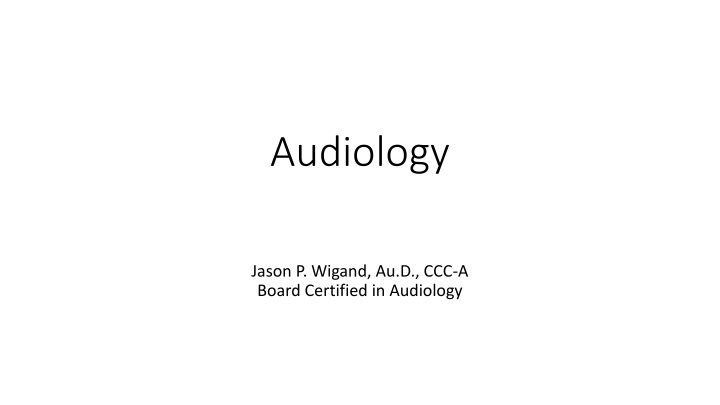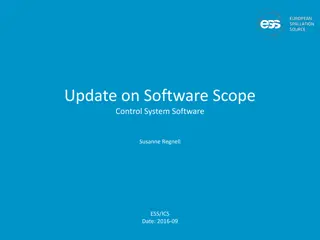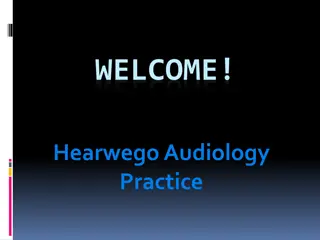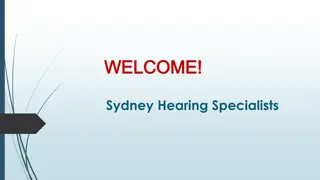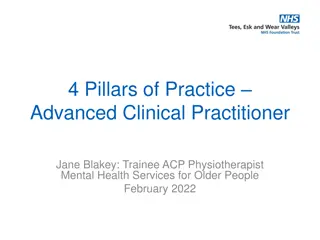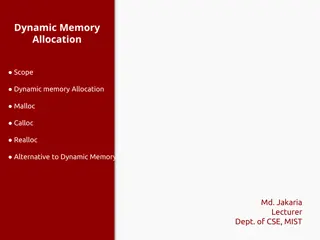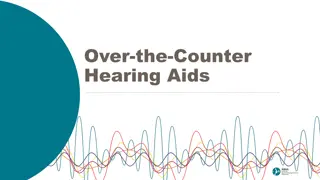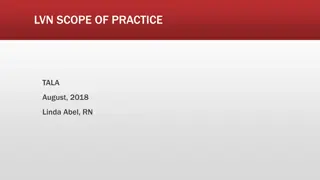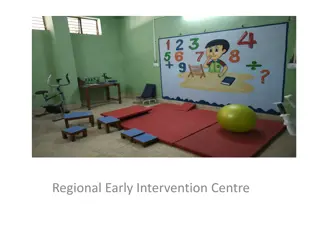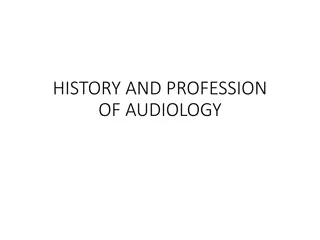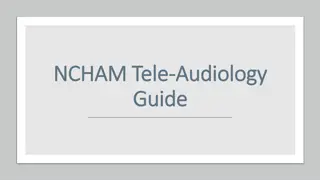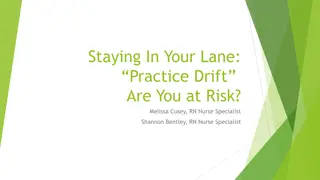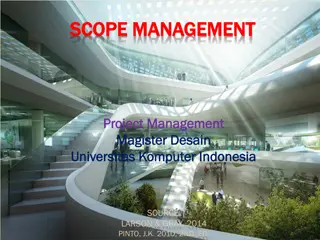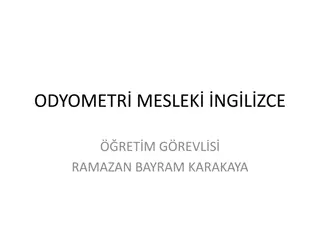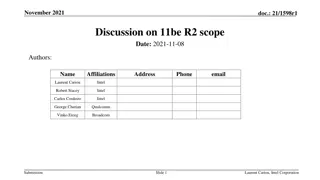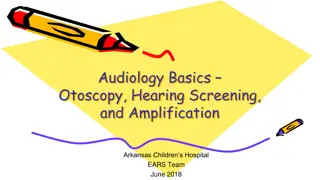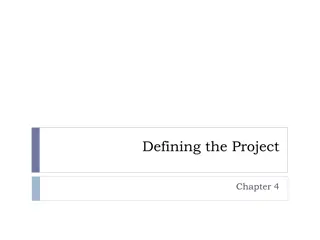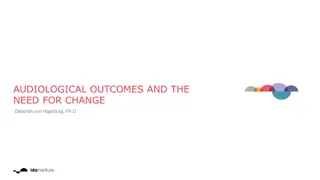Comprehensive Overview of Audiology Practice and Scope
Audiologists play a crucial role in evaluating, rehabilitating, and preventing hearing and balance disorders. They conduct various evaluations, provide rehabilitation interventions like hearing aids and counseling, and engage in prevention programs. Audiologists work in diverse settings and collaborate with other healthcare professionals. They require skills in communication, technical knowledge, and empathy. The educational requirement for audiologists has evolved to a clinical doctorate in audiology.
Download Presentation

Please find below an Image/Link to download the presentation.
The content on the website is provided AS IS for your information and personal use only. It may not be sold, licensed, or shared on other websites without obtaining consent from the author.If you encounter any issues during the download, it is possible that the publisher has removed the file from their server.
You are allowed to download the files provided on this website for personal or commercial use, subject to the condition that they are used lawfully. All files are the property of their respective owners.
The content on the website is provided AS IS for your information and personal use only. It may not be sold, licensed, or shared on other websites without obtaining consent from the author.
E N D
Presentation Transcript
Audiology Jason P. Wigand, Au.D., CCC-A Board Certified in Audiology
AUDIOLOGY SCOPE OF PRACTICE Evaluation, (re)habilitation, and prevention of: HEARING LOSS VESTIBULAR (BALANCE) DISORDERS
Evaluate Behavioral (subjective) hearing evaluations Hearing Screening / Newborn Hearing Screening Electrophysiological (objective) hearing evaluations OAEs, ABR, ECochG, ENOG, etc Balance Testing ENG/VNG, Rotary chair, Posturography, etc Auditory processing disorders Interoperative testing Refer to other professionals
Rehabilitation/Intervention Hearing Aids Classroom Acoustics Assistive Listening Devices Counseling/Education Cochlear Implants Cerumen Management Aural/Auditory Rehab and Training Vestibular Rehab Therapy
Prevention Industrial/military hearing conservation programs identify and remove hazardous noise identify/track hearing loss provide hearing protection - earplugs/earmuffs educate/train
WHERE DO THEY PRACTICE? Private Practice Community Hearing and Speech Clinics/Universities Physician Practice Universities Hospitals Device manufacturers Schools Industry
With whom do Audiologists work? Speech-Language Pathologists ENT physicians (Otolaryngologists), pediatricians, and other doctors Educators Occupational Therapists Psychologists Optometrists OSHA and Industrial Safety Managers Asha.org 7
Required Skills Relationships Technical skills/Knowledge of the technology Communicate diagnostic results Approach problems objectively Provide support to patients and families Patience and good listening skills Asha.org 8
Education Since the early 2000's, a clinical doctorate in audiology (Au.D.) has replaced the Master s degree as the entry-level degree for those who pursue clinical practice. 9
The Au.D. Clinical doctorate First 3 years: course work Science and math-based courses such as Neurology, Anatomy/Physiology, Acoustics, Statistics Clinic-prep courses such as Assessment, Hearing Aids, Aural Rehabilitation Clinic placements 4th Year: 12-month externship/residency Supervised full-time clinic setting Capstone Project Research project/dissertation Systematic review/thesis 10
Professional Requirements State Licensure Specified number of clinical hours Continued Education Hearing Aid Dispensing License (some states) Praxis National Audiology Exam Agree to Code of Ethics ASHA CCC-A or ABA Certification (optional) 11
The Audiogram Audiogram: A graph that shows an individuals type and degree of hearing loss as measured during the hearing test.
What is a cochlear implant?
Basic Principle Basic Principle A cochlear implant bypasses the damaged or missing sensory structures of the inner ear to stimulate the auditory nerve directly with an electrical equivalent of the sound signal. The majority of severe to profoundly hearing impaired individuals have sufficient remaining spiral ganglion cells for effective stimulation.
Anatomy of a Cochlear Implant Anatomy of a Cochlear Implant Transmitter Receiver Microphone & Processor Electrode array
How CIs Work How CIs Work Sound is picked up by processor microphones Processor codes the sound into an electrical signal based on the map and coding strategy Sound is sent from the external coil to the internal coil via radio waves Sound is sent to the electrodes Electrodes stimulate the VIIIth nerve with electrical impulses Sound transmitted to brain
Cochlear Implant Processing Cochlear Implant Processing Different electrodes stimulate nerve fibers at different places on the basilar membrane. Because they present information obtained from different frequencies, and they present this information to different locations, there is an inherent mismatch electrodes cannot always present information just where it belongs.
Anatomy of a Cochlear Implant Marking the position of the internal receiver The internal receiver in place
Realistic Expectations COCHLEAR IMPLANTS DO NOT RESTORE NORMAL HEARING!!!!!!!!! Harder at first, gets better over time Background noise still difficult Rely on speechreading/visual cues less over time however, they should still always be utilized
Factors affecting progress Pre-implantation Length of hearing loss Pre- or post-lingually deafened History of amplification/auditory stimulation Etiology of hearing loss Post-implantation How long and how frequently device is worn Practice, practice, practice AVT or aural rehabilitation Full insertion of electrode array
Cochlear Implants Cochlear Implants vs. vs. Hearing Aids Hearing Aids
A Few Questions: So, what are hearing aids actually doing? Hearing aids are making sounds louder. They are man s ATTEMPT to replace the function of damaged or missing OUTER HAIR CELLS. They improve ACCESS to sound. Can hearing aids significantly improve speech intelligibility? In short, NO. They are improving access to speech. Hearing aids cannot reverse the damage to the outer or inner hair cells. Remember, hearing aids still rely on the sound being transmitted through a DAMAGED system. LOUDER SPEECH CLEARER SPEECH
Limitations of amplified sound Outer Hair Cells give us very fine frequency discrimination by sharpening the peak of the traveling wave. Hearing aids make the traveling wave larger in amplitude, but the very fine frequency discrimination cannot be restored.
Videos Videos How we hear http://www.youtube.com/watch?v=tkPj4IGbmQQ&feature=related Organ of Corti http://www.youtube.com/watch?v=xMUl5CCoW6Y&feature=BFa&list= FLXQvG_Giv0_ZCy3lheomlgQ&lf=mh_lolz How a cochlear implant works http://www.youtube.com/watch?v=SmNpP2fr57A
Videos Videos Cochlear implant surgery http://www.youtube.com/watch?v=CpSPUm-ja_s&feature=related http://www.youtube.com/watch?v=WMe3yr2ZnUI
